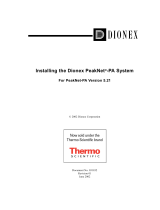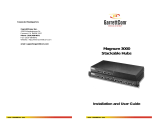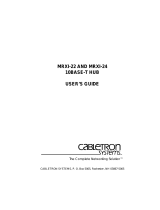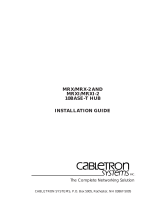Page is loading ...

Installing the Dionex PeakNet®-PA System
For PeakNet-PA Version 5.22
© 2002 Dionex Corporation
Document No. 031865
Revision 01
June 2002

©2002 by Dionex Corporation
All rights reserved worldwide.
Printed in the United States of America.
This publication is protected by federal copyright law. No part of this publication may be
copied or distributed, transmitted, transcribed, stored in a retrieval system, or transmitted
into any human or computer language, in any form or by any means, electronic,
mechanical, magnetic, manual, or otherwise, or disclosed to third parties without the
express written permission of Dionex Corporation, 1228 Titan Way, Sunnyvale, California
94088-3603 U.S.A.
DISCLAIMER OF WARRANTY AND LIMITED WARRANTY
THIS PUBLICATION IS PROVIDED “AS IS” WITHOUT WARRANTY OF ANY
KIND. DIONEX CORPORATION DOES NOT WARRANT, GUARANTEE, OR
MAKE ANY EXPRESS OR IMPLIED REPRESENTATIONS REGARDING THE
USE, OR THE RESULTS OF THE USE, OF THIS PUBLICATION IN TERMS OF
CORRECTNESS, ACCURACY, RELIABILITY, CURRENTNESS, OR
OTHERWISE. FURTHER, DIONEX CORPORATION RESERVES THE RIGHT
TO REVISE THIS PUBLICATION AND TO MAKE CHANGES FROM TIME TO
TIME IN THE CONTENT HEREINOF WITHOUT OBLIGATION OF DIONEX
CORPORATION TO NOTIFY ANY PERSON OR ORGANIZATION OF SUCH
REVISION OR CHANGES.
TRADEMARKS
DX-LAN™ is a trademark and PeakNet® is a registered trademark of Dionex
Corporation.
Wonderware InTouch® is a registered trademark of Wonderware Corporation.
Pentium® is a registered trademark of Intel Corporation.
Windows™ is a trademark and Windows NT® is a registered trademark of Microsoft
Corporation.
PRINTING HISTORY
Revision 01, June 2002

Contents
Doc. 031865-01 6/02 i
Installing the PeakNet-PA System
1 PeakNet-PA System Requirements . . . . . . . . . . . . . . . . . . . . . . . . . . . . . . . 1
2 PeakNet-PA Moduleware-BIOS Compatibility . . . . . . . . . . . . . . . . . . . . . 2
3 Installation Overview . . . . . . . . . . . . . . . . . . . . . . . . . . . . . . . . . . . . . . . . . 3
4 Installing the Computer DX-LAN Card . . . . . . . . . . . . . . . . . . . . . . . . . . . 4
4.1 Identifying the DX-LAN Card Type . . . . . . . . . . . . . . . . . . . . . 4
4.2 Installing the DX-LAN Card in the Computer . . . . . . . . . . . . . . 5
5 Connecting the DX-LAN Network . . . . . . . . . . . . . . . . . . . . . . . . . . . . . . . 6
5.1 Connecting a 10BASE-T DX-LAN Network (Overview) . . . . . 6
5.2 Connecting a BNC DX-LAN Network (Overview) . . . . . . . . . . 9
5.3 DX-LAN Network Connection Examples . . . . . . . . . . . . . . . . 11
6 Windows XP: Installing the DX-LAN Card Driver . . . . . . . . . . . . . . . . . 16
7 Windows 2000: Installing the DX-LAN Card Driver . . . . . . . . . . . . . . . . 18
8 Windows NT: Installing the DX-LAN Card Driver . . . . . . . . . . . . . . . . . 21
9 Installing PeakNet-PA Software . . . . . . . . . . . . . . . . . . . . . . . . . . . . . . . . 24
9.1 Installing PeakNet-PA Programs . . . . . . . . . . . . . . . . . . . . . . . 24
9.2 Installing Wonderware InTouch (Runtime) . . . . . . . . . . . . . . . 27
9.3 Installing the Runtime License . . . . . . . . . . . . . . . . . . . . . . . . . 37
9.4 Installing the InTouch Patch 02 . . . . . . . . . . . . . . . . . . . . . . . . 37
9.5 Setting the InTouch Path Variable . . . . . . . . . . . . . . . . . . . . . . 38
9.6 Setting Up InTouch to Start Automatically . . . . . . . . . . . . . . . 39
10 Setting the Time and Date Formats . . . . . . . . . . . . . . . . . . . . . . . . . . . . . . 42
11 Setting Up the Database . . . . . . . . . . . . . . . . . . . . . . . . . . . . . . . . . . . . . . 43
12 Selecting a Video Resolution (Optional) . . . . . . . . . . . . . . . . . . . . . . . . . . 46

Installing the PeakNet-PA System
ii Doc. 031865-01 6/02

Doc. 031865-01 6/02 1
Installing the PeakNet-PA System
NOTE When you purchase your PeakNet-PA software, all
necessary software and computer hardware are installed
at the factory. These instructions are for reference
should you need them at a later time.
1 PeakNet-PA System Requirements
The computer on which you install PeakNet-PA must meet the following
minimum system requirements:
•Microsoft® Windows® XP, Windows® 2000 (Service Pack 2), or Windows
NT®, Version 4.0 (Service Pack 6a)—installed before PeakNet-PA is installed
•Intel Pentium® 300 MHz computer
•256 MB RAM
•Hard disk with 1.5 GB of free space
•Monitor with 800 x 600 video resolution
•Database program that supports ODBC (for example, Microsoft Access)
•PCI or ISA expansion slot for the DX-LAN card
•(Optional) Printer supported by Windows (parallel interface recommended).
Color printer recommended for printing trend plots

Installing the PeakNet-PA System
2Doc. 031865-01 6/02
2 PeakNet-PA Moduleware-BIOS Compatibility
The Moduleware and BIOS of all installed Dionex devices must be compatible
with PeakNet-PA. Incompatibilities will cause system communication failures.
NOTE When running PeakNet-PA (release 5.22 or higher), the
BIOS version for all devices must be 30.00 or higher.
Before downloading new Moduleware to a device, check the following table to
verify that the Moduleware version number supports PeakNet-PA (release 5.22 or
higher).
How to Identify the Current Versions of Moduleware and BIOS
•Most devices display their Moduleware and BIOS versions at power-up.
•On many devices, you can also select the POWER-UP SCREEN from the
DIAGNOSTIC MENU to display the Moduleware and BIOS versions.
•On the UI20 Universal Interface, press the front panel Status button to
display the Moduleware and BIOS versions.
•From the PeakNet-PA Configuration Editor, select Moduleware from the
Configure menu to display the Moduleware version for any module.
Module Moduleware Version Module Moduleware Version
AD20 3.00 or higher EG40 2.25 or higher
AD25 1.00 or higher GP40 3.00 or higher
AS50 1.08 or higher GP50 3.00 or higher
CC80 5.26 or higher IC20 3.00 or higher
CD20 3.00 or higher IC25 1.00 or higher
CD25 1.00 or higher IP20 3.00 or higher
DX-120 3.01 or higher IP25 3.00 or higher
ED40 3.00 or higher UI20 3.01 or higher
ED50 1.00 or higher
Table 1. Moduleware Versions Required for PeakNet-PA (Release 5.22 or Higher) Support

Installation Overview
Doc. 031865-01 6/02 3
3 Installation Overview
Connect the
DX-LAN Network
Install the DX-LAN
Card Driver
Install the DX-LAN
Card in the Computer
Install PeakNet-PA
Software
Set Up the Database
Set the Tim e and
Date Formats
(Optional) Select a
Video Resolution
Turn on the DX-800
Analyzer Modules
Turn on the Computer
See page 4.
See page 6.
For Windows XP, see page 16.
For Windows 2000, see page 18.
For Windows NT, see page 21.
See page 24.
See page 42.
See page 43.
See page 46.

Installing the PeakNet-PA System
4Doc. 031865-01 6/02
4 Installing the Computer DX-LAN Card
4.1 Identifying the DX-LAN Card Type
Dionex ships PeakNet-PA systems with the following types of DX-LAN
cards:
•ISA Plug-and-Play card (P/N 052351)
•PCI Plug-and-Play card (P/N 052350)
•PCI Plug-and-Play card for 10BASE-T only (P/N 056908)
Before proceeding, check the card's part number and Figure 1 to
determine which type of card you have.
Windows XP, Windows 2000, or Windows NT must be installed on the
PeakNet-PA workstation before the card is installed.
Figure 1. Outside of DX-LAN Card Brackets
ISA Plug-and-Play PCI Plug-and-Play
(for 10BASE-T only
)
PCI Plug-and-Play

Installing the Computer DX-LAN Card
Doc. 031865-01 6/02 5
4.2 Installing the DX-LAN Card in the Computer
1. Turn off the computer and disconnect its power cord.
2. Remove the computer cover.
3. Locate an empty expansion slot into which the DX-LAN card will fit.
Use the type of slot appropriate for the card (either ISA or PCI). If
several slots are empty, leave as much space as possible around each
installed card to ensure adequate air circulation.
4. A metal filler bracket covers the rear panel opening for the selected
expansion slot. Unscrew and remove the bracket. Save the screw.
5. Carefully slide the DX-LAN card into the slot. Align the card's metal
mounting bracket with the expansion slot opening on the rear panel.
6. Align the card's bottom edge connectors with the connectors on the
motherboard. Firmly push the card into the motherboard connectors
until the card is fully seated.
7. Use the saved screw to secure the card's metal mounting bracket to
the expansion slot.
8. Replace the computer cover and any cables you removed.
To prevent electrostatic discharge from damaging the DX-LAN card's
electronic components, use an electrostatic grounding strap during
the installation. If one is not available, do the following: before
removing the card from its anti-static bag, touch the computer's metal
frame to discharge any static electricity from your body.
DO NOT TURN ON THE COMPUTER until after the DX-LAN network is
connected (see Section 5) and the power is turned on to at least one
of the DX-800 analyzer modules. This ensures that correct
communication is established between the DX-LAN card and the DX-
800 Analyzer modules.

Installing the PeakNet-PA System
6Doc. 031865-01 6/02
5 Connecting the DX-LAN Network
The DX-LAN network consists of a PeakNet-PA workstation and the devices in
each DX-800 analyzer channel. For example, a network might consist of a
workstation, a component controller, a detector, a pump, and an EG40-PA eluent
generator.
Each device (including the workstation) must be equipped with a DX-LAN
interface card, and either a BNC connector or a 10BASE-T RJ-45 (telephone-
style) connector. The channel’s AE80 enclosure is equipped with either two BNC
connectors (In and Out) or one 10BASE-T RJ-45 connector.
A DX-LAN network can include 10BASE-T devices only, BNC devices only, or a
combination of 10BASE-T and BNC devices. The installation procedure varies,
depending on the type(s) of DX-LAN devices on the network.
•For an overview of how to connect a 10BASE-T network, see Section 5.1.
•For an overview of how to connect a BNC network, see Section 5.2.
•For examples of various network configurations, see Section 5.3.
5.1 Connecting a 10BASE-T DX-LAN Network (Overview)
Required Parts
Part Part Number Quantity
10BASE-T DX-
LAN cables
960279–10 ft (3 m)
960281–6 ft (1.8 m)
960286–1 ft (0.3 m)
1 cable for each 10BASE-T
network device
10BASE-T “combo”
Ethernet hub
057398 1 or more, depending on the
network configuration
Table 2. Parts Required for 10BASE-T Network Connections
The 10BASE-T DX-LAN cable is a Category 5 unshielded twisted-pair
cable. Do not substitute a cable of an inferior grade. Using an
incorrect cable will cause a device to lose communication with the
host computer.
When using 10BASE-T cabling, you must install an Ethernet hub. If
you simply plug the 10BASE-T cable from a device into the connector
on the computer’s DX-LAN card, the connection will not work.

Connecting the DX-LAN Network
Doc. 031865-01 6/02 7
10BASE-T Network Connections for Networks with a Single Hub
1. Verify that a DX-LAN interface card is installed in each device to be
connected. For complete installation instructions for any Dionex
device, refer to the individual product manual.
2. Plug a 10BASE-T DX-LAN cable into a 10BASE-T port on the
Ethernet hub.
3. Plug the other end of the cable into the 10BASE-T DX-LAN
connector on the rear panel of a 10BASE-T device.
4. Repeat Steps 2 and 3 for the remaining 10BASE-T devices.
5. Set the Normal/Uplink push button on the hub to Normal.
Figure 2 shows example connections for a 10BASE-T network with one
hub.
Figure 2. Example 10BASE-T DX-LAN Network: Connecting to One Hub
87654321
10BASE-T
Device
10BASE-T
Device
10BASE-T
Device
(10BASE-T Device
)
10BASE-T Cable
Hub
10BASE-T Cables
Workstation

Installing the PeakNet-PA System
8Doc. 031865-01 6/02
10BASE-T Network Connections for Networks with Multiple Hubs
1. Verify that a DX-LAN interface card is installed in each device to be
connected. For complete installation instructions for any Dionex
device, refer to the individual product manual.
2. Set the Normal/Uplink push button on the first Ethernet hub to
Normal and set the push buttons on all other hubs to Uplink.
3. Using a 10BASE-T DX-LAN cable, connect port 8 on the second hub
to any port on the first hub. Repeat for other hubs in the network. The
Normal/Uplink push button affects port 8 only.
4. Using a 10BASE-T DX-LAN cable, connect the 10BASE-T network
devices to ports 1 through 7 on the second and subsequent hubs.
Figure 3 shows example connections for a 10BASE-T network with
multiple hubs.
Figure 3. Example 10BASE-T DX-LAN Network: Connecting to Multiple Hubs
Normal/Uplink
button =Normal
Hub 1
87654321
Hub 2 . . .
87654321
Hub x
87654321
Normal/Uplink
button =Uplink
Normal/Uplink
button =Uplink
10BASE-T
Device
10BASE-T
Device
10BASE-T
Device
10BASE-T
Device
(10BASE-T Device)
Workstation

Connecting the DX-LAN Network
Doc. 031865-01 6/02 9
5.2 Connecting a BNC DX-LAN Network (Overview)
1. Verify that a DX-LAN interface card is installed in each device to be
connected. For complete installation instructions for any Dionex
device, refer to the individual product manual.
2. Attach a BNC tee connector to the BNC connector on each device
and on the BNC port on the Ethernet hub, if used.
a. Twist the tee onto the BNC connector until the locking pins that
protrude from either side of the BNC connector are fully engaged
in the slots on the tee connector.
b. Pull firmly on the tee connector to verify that it cannot move.
Part Part Number Quantity
BNC tee connector 921914 1 for each BNC network device
including the 10BASE-T “combo”
Ethernet hub, if present
Coaxial DX-LAN
cable
960406 (3 ft)
960404 (6 ft)
960405 (15 ft)
046016 (50 ft)
Enough to connect each device in a
single line
50 ohm terminator
resistor plugs
921034 2; one for each end of the network
Table 3. Parts Required for BNC Network Connections
The coaxial DX-LAN cable is a 50 ohm coaxial impedance cable. (Fifty
ohm cables are imprinted with “RG-58U.”) Do not substitute an
inferior cable, such as a 75 ohm television coaxial cable. Failure to
use the correct cable or to lock it into place on the BNC tee connector
will cause the device to lose communication with PeakNet-PA.
A 50 ohm terminator resistor plug must be installed at each end of the
BNC DX-LAN network. Before beginning operation, verify that both
ends of the DX-LAN have terminator resistor plugs installed.

Installing the PeakNet-PA System
10 Doc. 031865-01 6/02
3. Connect a coaxial DX-LAN cable to the first device.
a. Slide the metal sleeve on the end of the DX-LAN cable over the
BNC tee connector.
b. Twist the metal sleeve onto the tee connector until the locking
pins on the tee are fully engaged.
c. Pull on the end of the cable to verify that it cannot move.
4. Plug the free end of the coaxial DX-LAN cable into one of the
following:
•The BNC tee connector on another device, or
•The BNC tee connector on the Ethernet hub (see Figure 4).
5. Repeat Steps 3 and 4 for each device to be connected.
6. Install 50 ohm terminator resistor plugs in the BNC tee connectors at
each end of the BNC DX-LAN network.
Figure 4 shows connections for an example BNC DX-LAN network.
Figure 4. Example BNC DX-LAN Network
BNC
Device
First BNC
Device on
Network
Last BNC
Device on
Network
Coaxial CableCoaxial Cable
10BASE-T Hub
TeeTee
or
Tee
Tee
Terminator Terminato
r
Terminator
NOTES:
Link the devices in a single line in
any order.
Install the PeakNet-PA workstation
anywhere in the network.
Install a terminator plug at each
end of the network.

Connecting the DX-LAN Network
Doc. 031865-01 6/02 11
5.3 DX-LAN Network Connection Examples
Example 1 (Figure 5) shows the DX-LAN connections for a dual-channel
DX-800 with the following configuration:
•The PeakNet-PA workstation and AE80 enclosures have 10BASE-T
(RJ-45) connectors
•In Channel 1, all devices have RJ-45 connectors
•In Channel 2, the CC80, pump, and detector have BNC connectors;
the EG40-PA eluent generator has an RJ-45 connector
Example 2 (Figure 6) shows the DX-LAN connections for a dual-channel
DX-800 with the following configuration:
•The PeakNet-PA workstation has a 10BASE-T (RJ-45) connector
•The AE80 enclosures have BNC DX-LAN connectors (In and Out)
•In Channel 1 and Channel 2, the CC80s, pumps, and detectors have
BNC connectors; the EG40-PA eluent generators have RJ-45
connectors
Example 3 (Figure 7) shows the DX-LAN connections for a single-
channel DX-800 with the following configuration:
•All devices have 10BASE-T (RJ-45) connectors
Example 4 (Figure 8) shows the DX-LAN connections for a dual-channel
DX-800 with the following configuration:
•The PeakNet-PA workstation and AE80 enclosures have BNC
connectors
•In Channel 1 and Channel 2, the CC80s, pumps, and detectors have
BNC connectors; the EG40-PA eluent generators have RJ-45
connectors

Installing the PeakNet-PA System
12 Doc. 031865-01 6/02
Figure 5. DX-LAN Network Connections:
Example 1
Pump
10BASE-T
Workstation
Normal/Uplink
=Normal
Hub
87654321
10BASE-T
Hub
87654321
CC80
10BASE-T
Detector
10BASE-T
EG40-PA
10BASE-T
Pump
BNC
Hub
87654321
CC80
BNC
Detector
BNC
EG40-PA
10BASE-T
Channel 1
AE80 Enclosure
Normal/Uplink
=Uplink
BNC Tee
BNC Tee
BNC Tee
BNC
Terminator
BNC
Terminator
RJ-45 RJ-45
RJ-45
RJ-45
RJ-45
RJ-45
RJ-45 RJ-45
Channel 2
AE80 Enclosure
Normal/Uplink
=Uplink
NOTES
Use 10BASE-T DX-LAN Category 5 unshielded twisted-pair cables for all
connections between RJ-45 connectors on the hub and the 10BASE-T devices.
Use BNC DX-LAN 50 ohm coaxial impedance cables (“RG-58U”) for all connections
between BNC devices (including the BNC connector on the hub).
Connect a 50 ohm terminating resistor at each end of the BNC DX-LAN network.

Connecting the DX-LAN Network
Doc. 031865-01 6/02 13
Figure 6. DX-LAN Network Connections:
Example 2
Hub
7654321
BNC
Terminator
BNC
Terminator
Pump
BNC
Hub
87654321
CC80
BNC
Detector
BNC
EG40-PA
10BASE-T
Normal/Uplink
= Normal
BNC Tee
BNC Tee
BNC Tee
BNC
IN
BNC
OUT
Pump
BNC
Hub
87654321
CC80
BNC
Detector
BNC
EG40-PA
10BASE-T
BNC Tee
BNC Tee
BNC Tee
Normal/Uplink
= Normal
BNC
IN
BNC
OUT
NOTES
Use 10BASE-T DX-LAN Cate
g
or
y
5 unshielded twisted-pair cables for all
connections between RJ-45 connectors on the hub and the 10BASE-T devices.
Use BNC DX-LAN 50 ohm coaxial impedance cables ( ) for all
connections between BNC devices
(
includin
g
the BNC connector on the hub
)
.
Connect a 50 ohm terminatin
g
resistor at each end of the BNC DX-LAN network.
“RG-58U”
Workstation
Normal/Uplink
=Normal
8
10BASE-T
RJ-45
Channel 1
AE80 Enclosure
Channel 2
AE80 Enclosure
RJ-45 RJ-45

Installing the PeakNet-PA System
14 Doc. 031865-01 6/02
Figure 7. DX-LAN Network Connections:
Example 3
NOTE
Use 10BASE-T DX-LAN Category 5 unshielded twisted-
pair cables for all connections between RJ-45
connectors on the hub and the 10BASE-T devices.
Pump
10BASE-T
Workstation
10BASE-T
Hub
87654321
CC80
10BASE-T
Detector
10BASE-T
EG40-PA
10BASE-T
Channel 1
AE80 Enclosure
Normal/Uplink
=Normal
RJ-45
RJ-45
RJ-45
RJ-45
RJ-45
RJ-45

Connecting the DX-LAN Network
Doc. 031865-01 6/02 15
Figure 8. DX-LAN Network Connections:
Example 4
BNC
Terminator
Pump
BNC
Hub
87654321
CC80
BNC
Detector
BNC
EG40-PA
10BASE-T
Normal/Uplink
= Normal
BNC Tee
BNC Tee
BNC Tee
BNC
IN
BNC
OUT
Pump
BNC
Hub
87654321
CC80
BNC
Detector
BNC
EG40-PA
10BASE-T
BNC Tee
BNC Tee
BNC Tee
Normal/Uplink
= Normal
BNC
IN
BNC
OUT
NOTES
Use BNC DX-LAN 50 ohm coaxial impedance cables ( ) for all
connections between BNC devices (including the BNC connector on the hub).
Connect a 50 ohm terminating resistor at each end of the BNC DX-LAN network.
Use 10BASE-T DX-LAN Category 5 unshielded twisted-pair cables for all
connections between the RJ-45 connectors on the hub and the 10BASE-T
devices.
“RG-58U”
Workstation
BNC
Channel 1
AE80 Enclosure
Channel 2
AE80 Enclosure
RJ-45 RJ-45
BNC
Terminator

Installing the PeakNet-PA System
16 Doc. 031865-01 6/02
6 Windows XP: Installing the DX-LAN Card Driver
1. After installing the DX-LAN card in the computer (see Section 4) and cabling
the DX-LAN network (see Section 5), turn on at least one of the DX-800
Analyzer modules. Then, turn on the computer. Log on as the administrator.
When Windows XP starts, it detects the new card and automatically installs
the driver.
2. When Windows XP has finished starting, open the Control Panel and double-
click the Network Connection icon.
The Network Connection dialog box appears. The contents of the dialog box
vary, depending on which network cards were previously installed in the
computer. In the following example, two LAN cards are installed. The first
LAN connection is for the DX-LAN. The second connection is for the
company’s network.
Do not install PeakNet-PA software until after both the DX-LAN
card and the driver are installed.
To install the DX-LAN card driver and PeakNet-PA, you must be
logged onto Windows XP with administrator privileges. If
necessary, ask the Windows XP administrator to grant you
administrator privileges temporarily. Administrator privileges are
not required to run PeakNet-PA.
/













